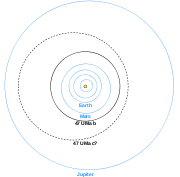
47 Ursae Majoris d
Encyclopedia
47 Ursae Majoris d (sometimes abbreviated 47 Uma d) is an extrasolar planet
approximately 46 light-year
s away in the constellation
of Ursa Major
. The planet was discovered located in a long-period
orbit (38 years) around the star 47 Ursae Majoris
. As of 2011, it is the outermost of three known planets in its planetary system
. It has a mass of at least 1.64 times that of Jupiter
. It is the longest-period planet detected by Doppler spectroscopy
. The evidence of this planet was found by Bayesian Kepler periodogram in March 2010.

Extrasolar planet
An extrasolar planet, or exoplanet, is a planet outside the Solar System. A total of such planets have been identified as of . It is now known that a substantial fraction of stars have planets, including perhaps half of all Sun-like stars...
approximately 46 light-year
Light-year
A light-year, also light year or lightyear is a unit of length, equal to just under 10 trillion kilometres...
s away in the constellation
Constellation
In modern astronomy, a constellation is an internationally defined area of the celestial sphere. These areas are grouped around asterisms, patterns formed by prominent stars within apparent proximity to one another on Earth's night sky....
of Ursa Major
Ursa Major
Ursa Major , also known as the Great Bear, is a constellation visible throughout the year in most of the northern hemisphere. It can best be seen in April...
. The planet was discovered located in a long-period
Orbital period
The orbital period is the time taken for a given object to make one complete orbit about another object.When mentioned without further qualification in astronomy this refers to the sidereal period of an astronomical object, which is calculated with respect to the stars.There are several kinds of...
orbit (38 years) around the star 47 Ursae Majoris
47 Ursae Majoris
47 Ursae Majoris is a solar analog, yellow dwarf star approximately 46 light-years away from Earth in the constellation of Ursa Major. , it has been confirmed that three Jupiter-like extrasolar planets orbit the star...
. As of 2011, it is the outermost of three known planets in its planetary system
Planetary system
A planetary system consists of the various non-stellar objects orbiting a star such as planets, dwarf planets , asteroids, meteoroids, comets, and cosmic dust...
. It has a mass of at least 1.64 times that of Jupiter
Jupiter
Jupiter is the fifth planet from the Sun and the largest planet within the Solar System. It is a gas giant with mass one-thousandth that of the Sun but is two and a half times the mass of all the other planets in our Solar System combined. Jupiter is classified as a gas giant along with Saturn,...
. It is the longest-period planet detected by Doppler spectroscopy
Doppler spectroscopy
Doppler spectroscopy, also known as radial velocity measurement, is a spectroscopic method for finding extrasolar planets. It involves the observation of Doppler shifts in the spectrum of the star around which the planet orbits....
. The evidence of this planet was found by Bayesian Kepler periodogram in March 2010.

See also
- 47 Ursae Majoris in fiction

